Verdigris
Table of Contents
Date and Time:
2017.January.23, 09:00pm-09:30pm
Location:Apt at W 106 St.Subject: Verdigris grow
The two verdigris recipes in Merrifield’s book are different in terms of ingredients, instruments, complexity and duration of the process. However, they both involve in a similar technique that keeping copper along with something acid in a warm place.
Merrifield pg. 124
Merrifield pg. 118
The one on page 124 describes a simple process by hanging several strips of cooper or brass over “most acid vinegar” in a jar, then keeping it for six months. The other recipe is more complex. The strips of copper should be wet by wine or vinegar, coated with a thin layer of salt, and hung over wine, beer or urine inside a vase. The vase should be put in “plenty of horse dung” (in order to keep it warm). Then after 8 or 9 days, the salt turned green with “excellent colour”, and after 17 or 19 days, the verdigris is ready to remove.
The second recipe states the influence of material and temperature on the form of verdigris, “if they are copper, the work will be done—i.e. the color will be made sooner; but if they are made of brass it will be longer before it is made. Heat accelerates the formation of the colour, cool weather retards it.”
As Cennino d’ Andrea Cennini stated in his book, “A color known as verdigris is green. It is very green by itself. And it is manufactured by alchemy, from copper and vinegar.” (Cennino d’Andrea Cennini, The Craftsman’s Handbook, Il Libro dell’Arte’, trans. by Daniel Thompson, New York: Dover, 1960, p. 33). A mid-8th century book of materia medica in China had recorded the use of verdigris in Chinese medicine, and described it as “the essence of copper”, and the famous Compendium of Materia Medica 本草綱目 also recorded the method for making verdigris in 16 century China that “people use vinegar to process copper, thus green grows from it, which would be collected, sun-dried, and sold.”
Making_Verdigris
This page recorded several old recipes for making verdigris, though has different details, all involve in the basic technique of keeping copper and vinegar (urine is also used as an alternative) in a warm place. Most of the recipes emphasize the point that the copper should not touch the vinegar. It makes sense as some of the chemicals in verdigris can be dissolved in acid, or at least some of the verdigris can be washed down into the vinegar, making it difficult to collect. However, one of the recipes is exceptional that it requires the cooper to be submerged in the vinegar, while the final step will be taking the sludge and drying it out, spending more time than simply scrape off from copper plates. Pliny’s recipe requires more work that vinegar is sprinkled “upon copper filings, and stir them frequently with a spatula in the course of the day, until they are completely dissolved.” Sprinkling vinegar rather than submerging in vinegar would probably made the final drying process easier.
However, there were more complicated ways of making verdigris in medieval Europe, many of which is listed and analyzed in David A. Scott, Copper and Bronze in Art: Corrosion, Colorants, Conservation, Los Angeles: Getty Publications, 2002, pp. 281-290.
See here:
The first recipe quoted in the section is from Theophilus. It has more materials other than copper and vinegar. “take a dish full of salt and, firmly compressing it, put it in the fire and cover it with coal overnight. The next day, very carefully grind it on a drug stone. Next gather some small twigs, place then in the above-mentioned hollow box so that two parts of the cavity are below and a third above, coat the copper sheets on each side with pure honey over which you sprinkle pounded salt.” This recipe requires salt painted on the surface of the copper, similar to the second recipe of Merrifield’s, except that it uses honey rather than vinegar to made the salt adhere to the copper.
According to this work, the use of salt in making verdigris will inevitably yield more complicated chemical mixtures including basic and neutral copper acetates and atacamite. It further suggests the honey is not only used as a adhesive but also interacts with other ingredients. There is a sentence states “some nantokite, CuCl, was found in areas associated with the honey, which suggests that the reducing sugars in the honey had a significant effect on the corrosion of the copper in this case.” (p.281) I did not get the point first, but it soon became clear as I started the experiment. Theophilus also has another recipe for Spanish green which emphasize “without honey and salt”, suggesting it’s a common practice to add honey and salt in the making of verdigris, while these two ingredients do have effect on the color of the final product.
The book lists more than a dozen of recipes for making verdigris, all involved in a similar process, while have variation on the use of ingredients. Concerning the ingredients and instruments at hand, I finally developed two ways to grow verdigris that I’d like to try and compare.
First, simply hang a piece of copper above vinegar (with the mother) in a jar.
Second, painted honey on the copper and sprinkle founded salt on to it, then hang the copper over vinegar in a jar.
This picture show the all the materials I used in the verdigris grow, including: a piece of copper plate (will be cut in to two pieces), two strings, two jars (it's better to be of the same size, but one of them was from the class, and the other one was kindly provided by my landlady), vinegar a pair of scissors, salt, pure honey, a mortar and a pestle.
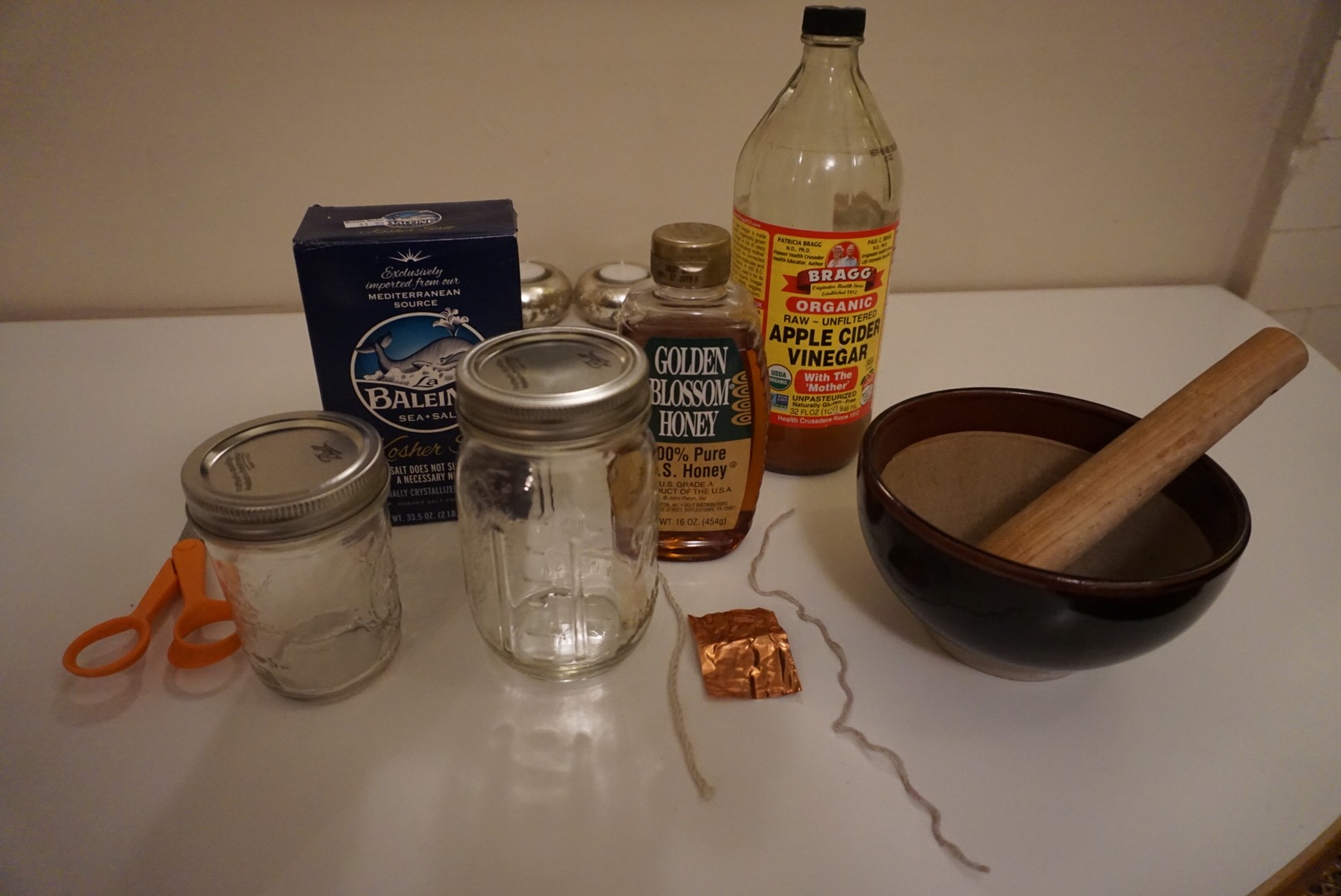
First I need to determine what kind of vinegar should be used in the reconstruction. Most recipes recommend hight acid and strong vinegar. As most of the lab notes of the students from the same lab seminar in previous semesters recommend to use the kind of vinegar "with the mother". The "mother" of vinegar is a substance composed of a form of cellulose and acetic acid bacteria that develops on fermenting alcoholic liquids, which turns alcohol into acetic acid with the help of oxygen from the air. Apple Cider vinegar is organic, unrefined, unpasteurized, and unfiltered, which can probably be a better imitation of the vinegar used in the middle ages. It's also high in acetic acid which is crucial in developing verdigris.
Then the amount of vinegar used in the recipes should be decided. None of the original recipes give an instruction on the amount of vinegar applied. It could probably be understood as "the more, the better". Whereas the vinegar left in the bottle (also a generous support from my landlady) is limited, and I need to prepare to set of device to grow the verdigris. I decided to add the vinegar until it reached the one-third of the small jar, then add approximately the same amount of vinegar into the larger jar.

This picture shows how I set the first half of the copper (with out honey and salt) into the small jar with vinegar. I just simply folded the plate and hung it on the string over the vinegar.
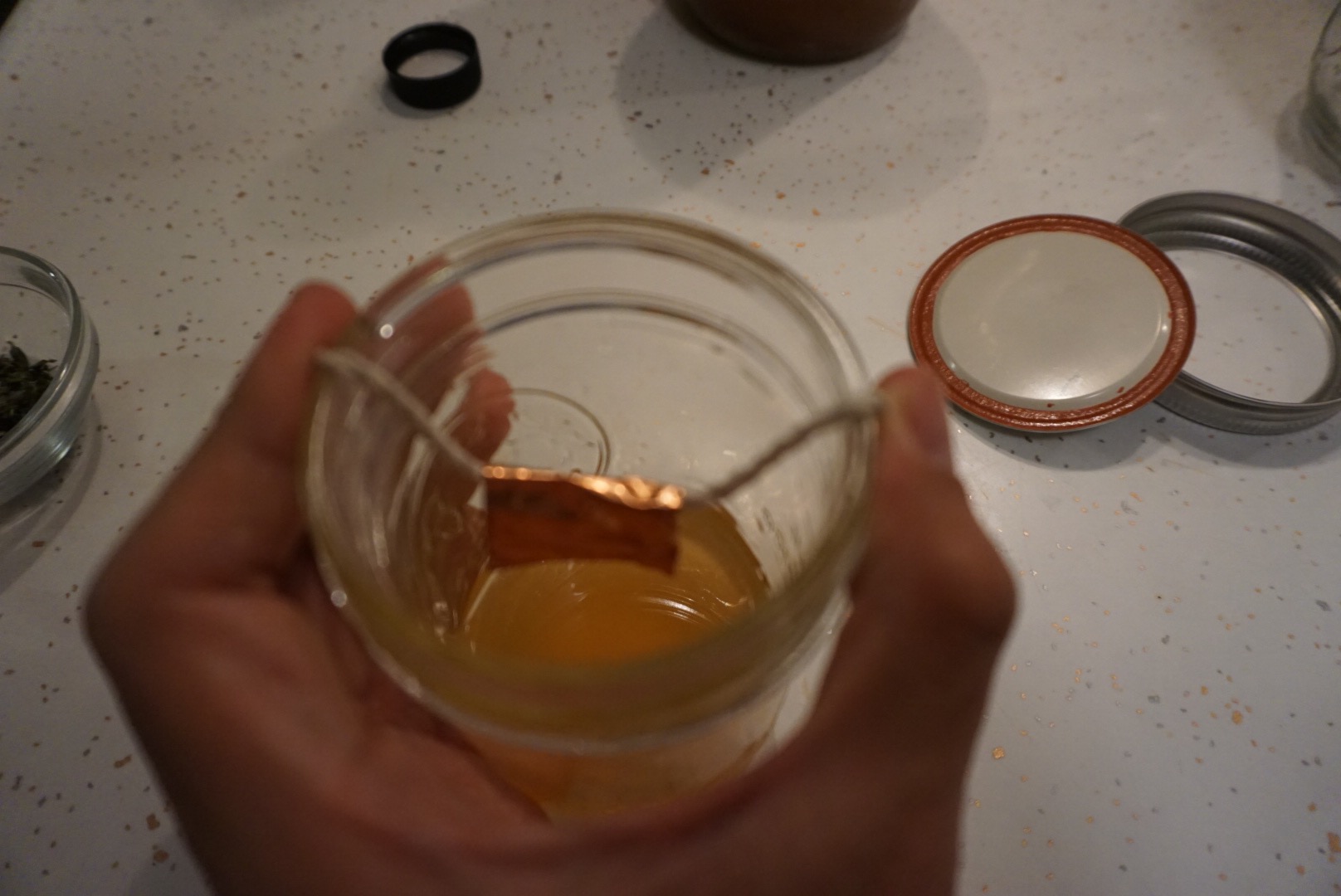
Then I started to prepare the other set. First, grind the salt in a mortar.
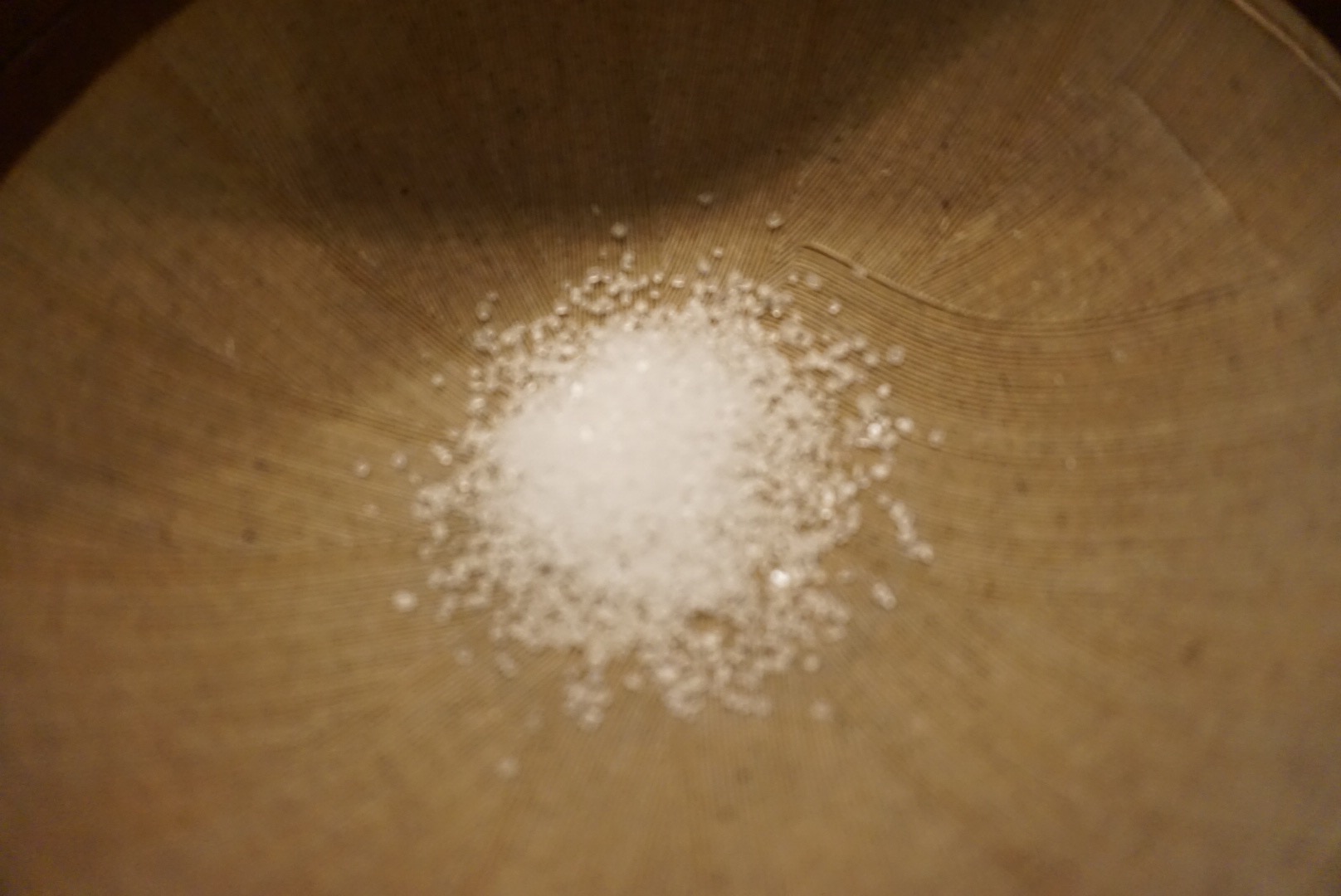
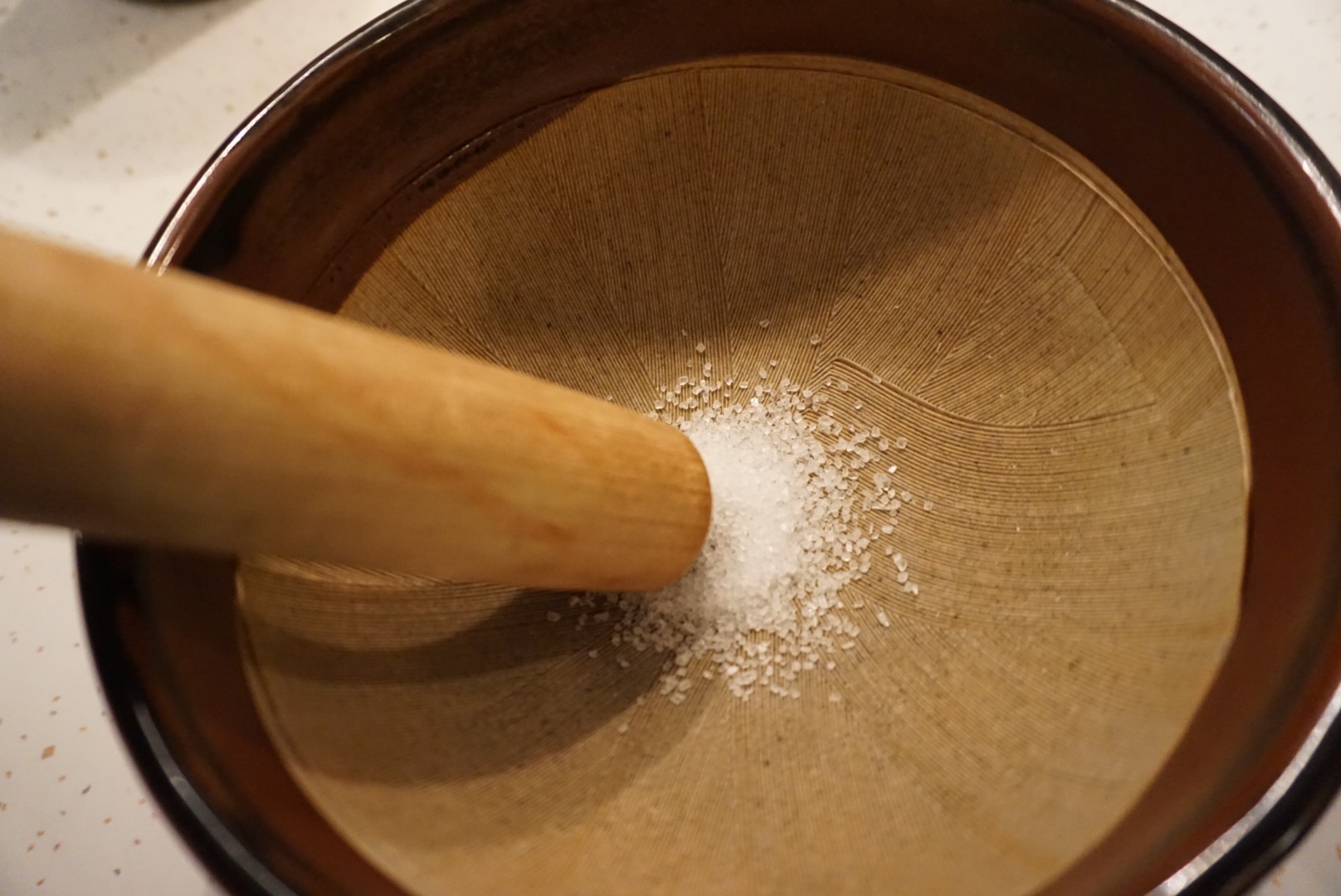
Then paint honey on the copper plate, and sprinkle ground salt onto the plate, making it as even as possible. However, due to the sticky honey on the surface, it's hard to sprinkle the salt homogeneously on the surface, it could be better if I add the salt into the honey and stir to make it evenly spread in the honey. Or, perhaps the use of vinegar on the surface will be better, as the salt can dissolve into the liquid.
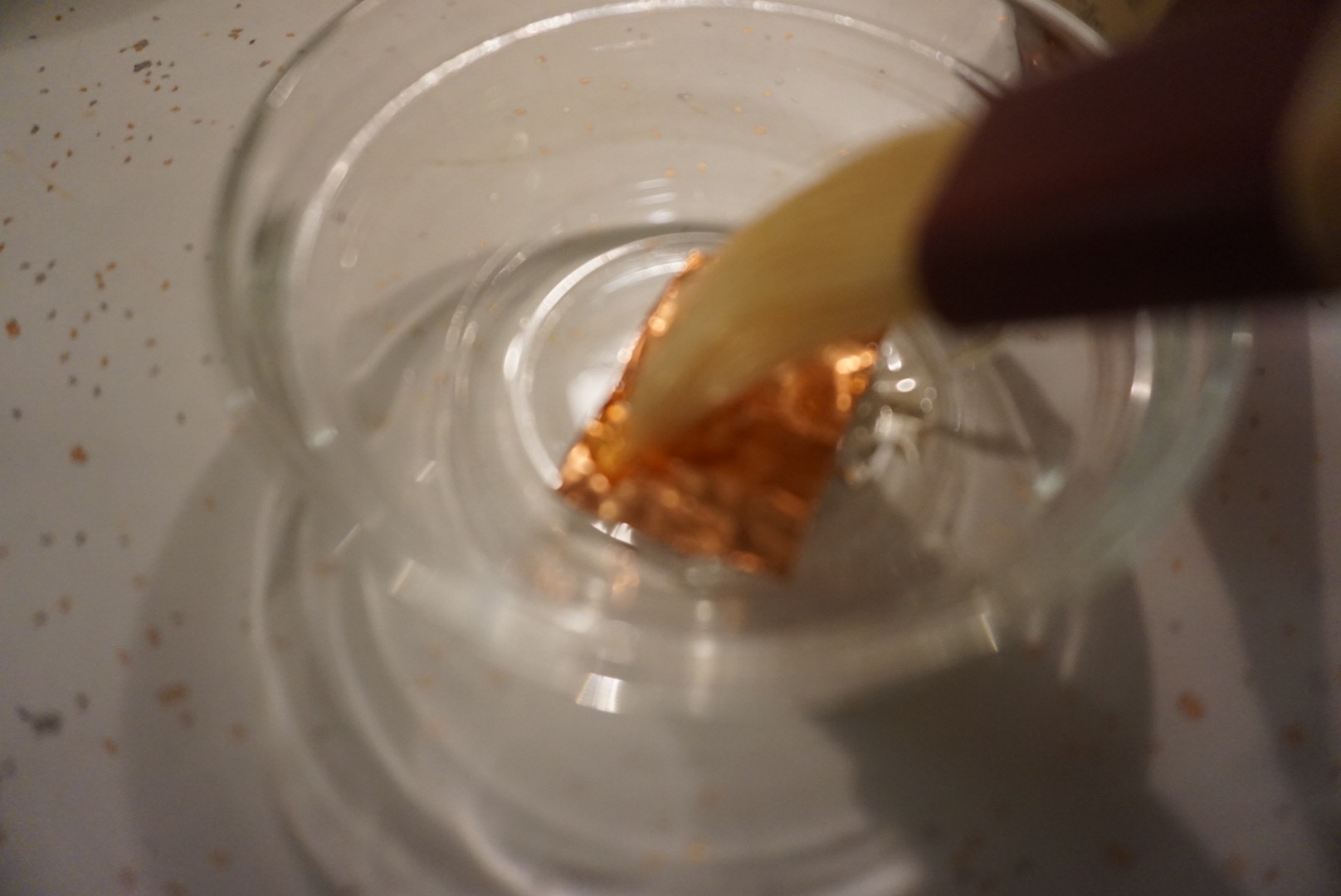
The two sets were prepared. Put them in my warm closet and wait for the verdigris to grow.
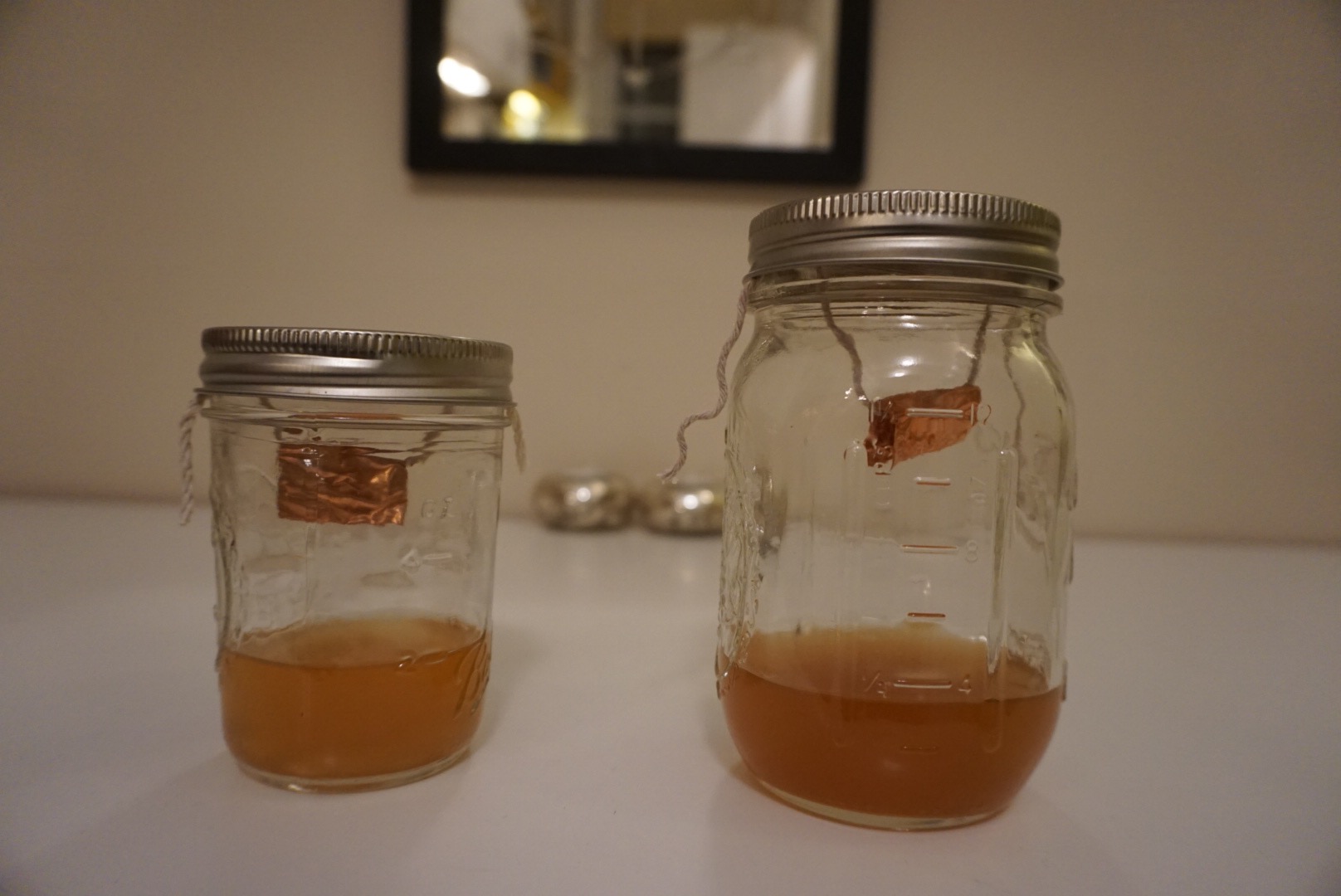
Name: Xiaomeng Liu
Date and Time:
2017.January.24, 12:30pm
Location: Apt at W 106th St.Subject: Verdigris Observation
The next day, when I opened the closet and took a look at jars inside. I'm surprised that the verdigris had already grown.
On the right side is the large jar with salt and honey, and the left is the small one without.
I can observe the specific differences of the verdigris grown on the two copper plates. On the one with honey and salt, lumps of verdigris had grown and specifically grew on the spots where there was salt sticking on it, while the other part of the plate remained uncontaminated. On the other plate without honey and salt, however, verdigris grows in a much lesser amount but evenly spread on the whole surface. Both of the verdigris have a beautiful light green color at this stage.
It makes sense that adding salt will accelerate the grow of verdigris, so that the second recipe of Merrifield with salt will spend much lesser time than the one without.
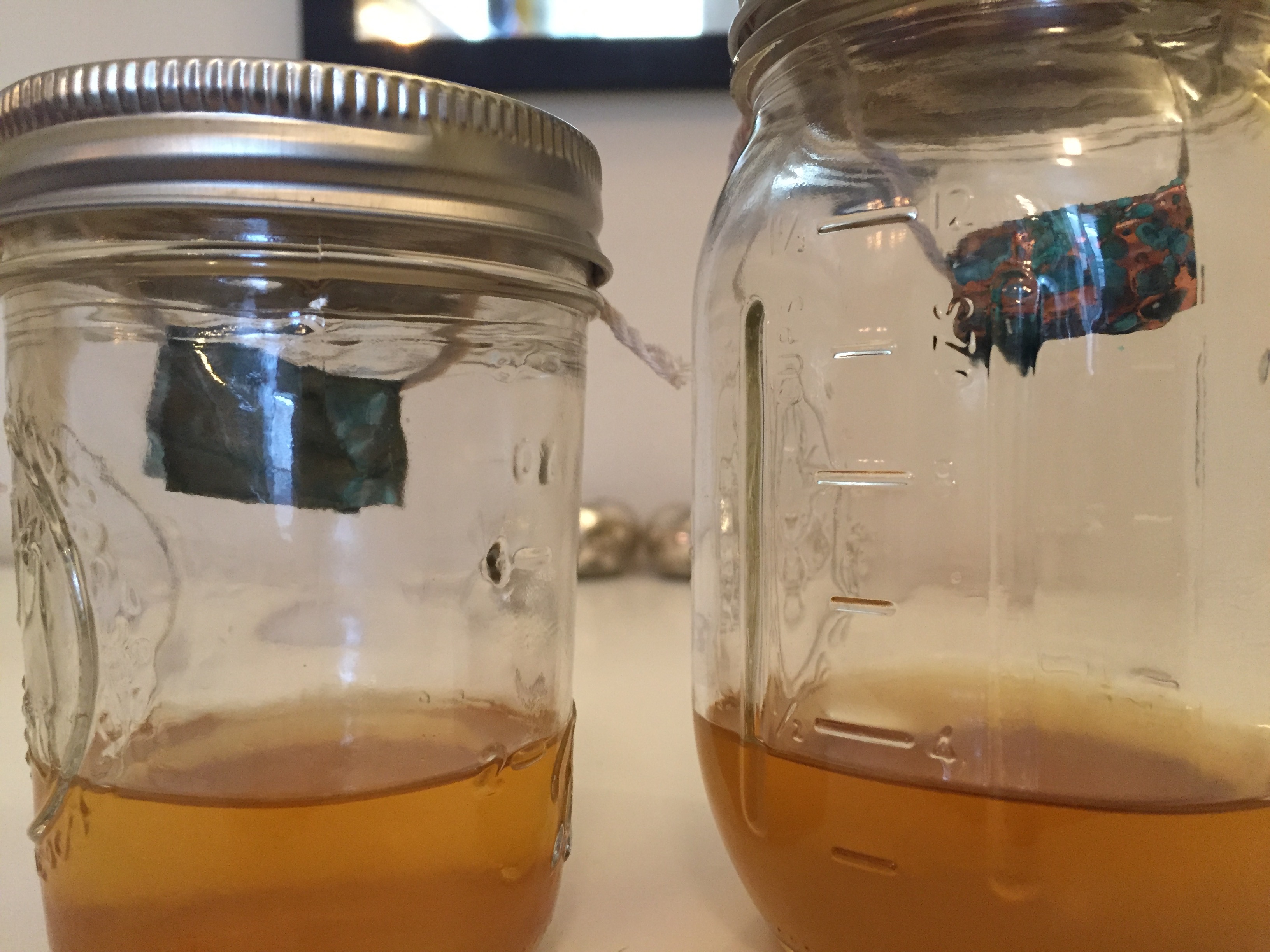
123
Name: Xiaomeng Liu (Other classmates were also in the lab doing their own verdigris painting, while all the teachers and TAs were there to instruct and help)
Date and Time:
2017.Feburary.06, 01:00pm-02:15
Location:Chandler 260, Making and Knowing labSubject: Verdigris Painting out
Before the class on Feb. 06, the verdigris had been grown for two weeks. I observed it regularly at the noon of each day. The copper plate in the small jar changed very slow, but it still grew little by little. The verdigris in the large jar, on the other hand, seemingly stopped to grow while the color became darker and darker. The plate with honey and salt remained moist, and I saw drips dropping down from the plate along with some verdigris, making the vinegar underneath more turbid.
In the morning of Feb. 6, I took the copper plates out of the jar. When I tried to separate the plate from the string, the one with honey and salt turned out to be brittle. It broke on the folding line when I tried to pull the string out from the plate. Then I had to stop and put the plates along with the string in two separate plastic bags. The other plate without honey and salt still remained its original texture with a thin smooth layer of verdigris spread on the surface. The verdigris did grow compare to the result of the first day, but it was still a thin layer that did not seems enough for painting out.
Before class, I saw the verdigris of other classmates, which turned out to be better grown than mine. I especially like the one Tianna brought which has been kept for 4 month. The verdigris looked like a smooth layer of green fur spread on the surface of plate.
The lab time started approximately at 1pm.
The first step was to scrape off the verdigris from the copper plates by a scrapper. I found the one with honey and salt is highly corroded and too brittle to get the verdigris off. I had to abandon this piece of copper and worked on the other piece. My experiment with honey and salt turned out to be unsuccessful. I only got half the amount of the verdigris comparing to the other students, so that I didn't have enough material to try both the linseed oil and walnut oil. I chose to add two drops of linseed oil into the verdigris, and ground it with a glass muller. Originally, my verdigris has a dark green color, after mixing with linseed oil and painting out on the board, it became bluish green.
ASPECTS TO KEEP IN MIND WHEN MAKING FIELD NOTES
- note time
- note (changing) conditions in the room
- note temperature of ingredients to be processed (e.g. cold from fridge, room temperature etc.)
- document materials, equipment, and processes in writing and with photographs
- notes on ingredients and equipment (where did you get them? issues of authenticity)
- note precisely the scales and temperatures you used (please indicate how you interpreted imprecise recipe instruction)
- see also our informal template for recipe reconstructions